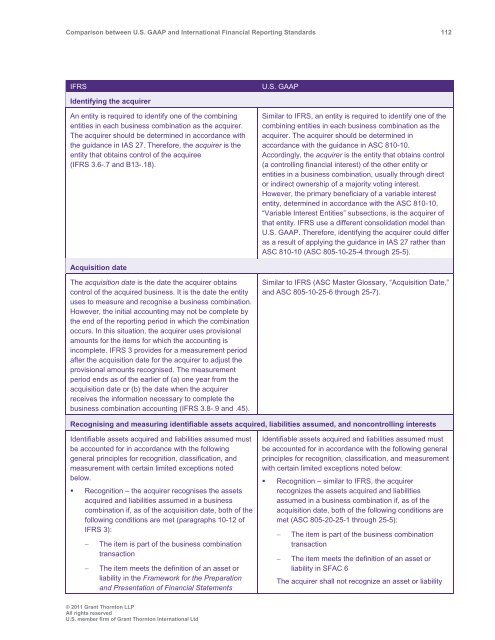Comparison between U.S. GAAP and International ... - Grant Thornton
Comparison between U.S. GAAP and International ... - Grant Thornton
Comparison between U.S. GAAP and International ... - Grant Thornton
You also want an ePaper? Increase the reach of your titles
YUMPU automatically turns print PDFs into web optimized ePapers that Google loves.
<strong>Comparison</strong> <strong>between</strong> U.S. <strong>GAAP</strong> <strong>and</strong> <strong>International</strong> Financial Reporting St<strong>and</strong>ards 112<br />
IFRS<br />
U.S. <strong>GAAP</strong><br />
Identifying the acquirer<br />
An entity is required to identify one of the combining<br />
entities in each business combination as the acquirer.<br />
The acquirer should be determined in accordance with<br />
the guidance in IAS 27. Therefore, the acquirer is the<br />
entity that obtains control of the acquiree<br />
(IFRS 3.6-.7 <strong>and</strong> B13-.18).<br />
Similar to IFRS, an entity is required to identify one of the<br />
combining entities in each business combination as the<br />
acquirer. The acquirer should be determined in<br />
accordance with the guidance in ASC 810-10.<br />
Accordingly, the acquirer is the entity that obtains control<br />
(a controlling financial interest) of the other entity or<br />
entities in a business combination, usually through direct<br />
or indirect ownership of a majority voting interest.<br />
However, the primary beneficiary of a variable interest<br />
entity, determined in accordance with the ASC 810-10,<br />
“Variable Interest Entities” subsections, is the acquirer of<br />
that entity. IFRS use a different consolidation model than<br />
U.S. <strong>GAAP</strong>. Therefore, identifying the acquirer could differ<br />
as a result of applying the guidance in IAS 27 rather than<br />
ASC 810-10 (ASC 805-10-25-4 through 25-5).<br />
Acquisition date<br />
The acquisition date is the date the acquirer obtains<br />
control of the acquired business. It is the date the entity<br />
uses to measure <strong>and</strong> recognise a business combination.<br />
However, the initial accounting may not be complete by<br />
the end of the reporting period in which the combination<br />
occurs. In this situation, the acquirer uses provisional<br />
amounts for the items for which the accounting is<br />
incomplete. IFRS 3 provides for a measurement period<br />
after the acquisition date for the acquirer to adjust the<br />
provisional amounts recognised. The measurement<br />
period ends as of the earlier of (a) one year from the<br />
acquisition date or (b) the date when the acquirer<br />
receives the information necessary to complete the<br />
business combination accounting (IFRS 3.8-.9 <strong>and</strong> .45).<br />
Similar to IFRS (ASC Master Glossary, “Acquisition Date,”<br />
<strong>and</strong> ASC 805-10-25-6 through 25-7).<br />
Recognising <strong>and</strong> measuring identifiable assets acquired, liabilities assumed, <strong>and</strong> noncontrolling interests<br />
Identifiable assets acquired <strong>and</strong> liabilities assumed must<br />
be accounted for in accordance with the following<br />
general principles for recognition, classification, <strong>and</strong><br />
measurement with certain limited exceptions noted<br />
below.<br />
• Recognition – the acquirer recognises the assets<br />
acquired <strong>and</strong> liabilities assumed in a business<br />
combination if, as of the acquisition date, both of the<br />
following conditions are met (paragraphs 10-12 of<br />
IFRS 3):<br />
<br />
<br />
The item is part of the business combination<br />
transaction<br />
The item meets the definition of an asset or<br />
liability in the Framework for the Preparation<br />
<strong>and</strong> Presentation of Financial Statements<br />
Identifiable assets acquired <strong>and</strong> liabilities assumed must<br />
be accounted for in accordance with the following general<br />
principles for recognition, classification, <strong>and</strong> measurement<br />
with certain limited exceptions noted below:<br />
• Recognition – similar to IFRS, the acquirer<br />
recognizes the assets acquired <strong>and</strong> liabilities<br />
assumed in a business combination if, as of the<br />
acquisition date, both of the following conditions are<br />
met (ASC 805-20-25-1 through 25-5):<br />
<br />
The item is part of the business combination<br />
transaction<br />
The item meets the definition of an asset or<br />
liability in SFAC 6<br />
The acquirer shall not recognize an asset or liability<br />
© 2011 <strong>Grant</strong> <strong>Thornton</strong> LLP<br />
All rights reserved<br />
U.S. member firm of <strong>Grant</strong> <strong>Thornton</strong> <strong>International</strong> Ltd
















